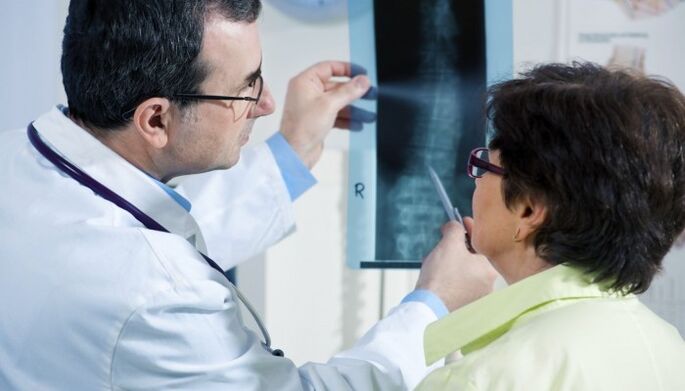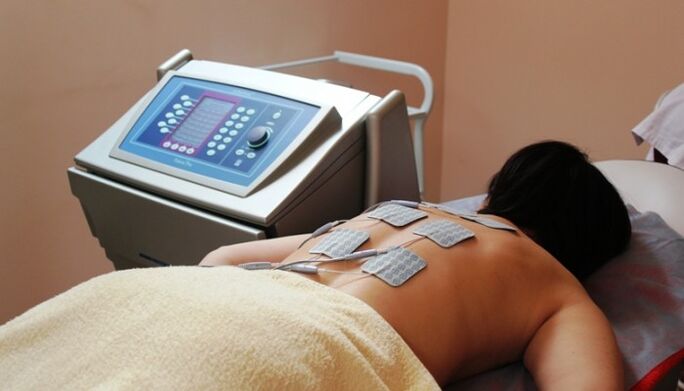Osteochondrosis is a chronic pathology of the spine, the root cause of which is degenerative changes in the intervertebral disc. As the disease progresses, other structures of the spine are also involved in the pathological process - the spinal cord, intervertebral joints, ligaments, etc.
The disease affects people of all ages. Until recently, osteochondrosis was considered a problem in the elderly, but recently there has been an increase in the incidence of the disease among young people. Both women and men get sick equally often.
Why does osteochondrosis occur?
To better understand what osteochondrosis is, it is necessary to briefly dwell on the causes and mechanisms of its occurrence.
The formation of pathological changes in osteochondrosis of the spine occurs slowly. Years often pass from the onset of the pathological process in the intervertebral cartilage to the onset of the first symptoms of osteochondrosis.
Causes of osteochondrosis
Spinal health is directly affected by many negative factors. If their effect is carried out for a long time, the result is the appearance of pathological changes in the structures of the spine. And it contributes to the development of osteochondrosis.
For example, osteochondrosis is well known to overweight people who lead a sedentary lifestyle. Excessive physical activity, back and neck injuries, and some somatic diseases can also lead to the development of this pathology. And aggravated heredity and old age are direct factors that lead to the development of degenerative damage to the cartilage tissue of the discs.
How does osteochondrosis develop?
The mechanism of development (or pathogenesis) of osteochondrosis is still controversial and insufficiently studied. It is likely that this disease is formed on the basis of metabolic disorders in the structures of the spine.
Under the influence of adverse factors, irreversible changes often occur in the cartilage tissue of the intervertebral disc, followed by its gradual destruction (or destruction).
The pathological process then spreads to the bone tissue of the vertebrae with the development of its deformation and the development of irreversible changes in the surrounding structures.
The appearance of such changes in the intervertebral disc directly depends on its anatomical nuances:
- Cartilage tissue does not have its own blood supply system. Its nutrition is provided by the bone tissue of neighboring vertebrae. Therefore, in the case of circulatory disorders in the spine due to insufficient or, conversely, excessive physical exertion, cartilage nutrition also suffers.
- There are no nerve fibers in the cartilage. As a result, there will be no timely transmission of nerve impulses, which leads to the activation of metabolism by functional overload of the intervertebral disc.
- The ability of the intervertebral disc cartilage to heal itself is structurally delayed.
There are other factors that clearly contribute to the development of degenerative processes in the cartilage tissue of the intervertebral discs and the formation of osteochondrosis.
Stages of pathological changes
Based on the available information on the pathogenesis of this pathology, it is possible to conditionally distinguish several stages of the degenerative process in the intervertebral disc. Stages of osteochondrosis of the spine:
- Primary. The cartilage tissue of the disc undergoes structural changes under mechanical influences - its dysfunction occurs. It is characterized by the appearance of cracks on the surface of the disk, which differ in size and depth. Later, these cracks turn into protrusions (hernias).
- Intermediate. It is characterized by the appearance of instability of the affected area of the spine due to pathological mobility of the spine. In this case, one of the main functions of the spine, the protective function, is violated. The nerve and vascular trunks flowing through its bone canals are sensitive. Bright clinical signs of the disease develop.
- Finite. There is a replacement of the affected cartilage tissue with coarser and denser fibers. At the same time, intervertebral hernias disappear. And the pathological mobility of the vertebrae is replaced by a sharp restriction of their mobility. Often there is a narrowing of the spinal canal with the development of manifestations of compression of segments of the spinal cord.
Therefore, each stage of the disease is undoubtedly characterized by the presence of specific symptoms that play a key role in the choice of treatment for osteochondrosis.
Clinical manifestations
Symptoms of osteochondrosis of the spine appear as changes in the bone tissue of the vertebrae. The patient can not complain for a long time.
The disease is characterized by a chronic course of alternating stages of exacerbation and remission.
Often, exacerbation of osteochondrosis occurs under the influence of stimuli: physical stress, hypothermia, prolonged exposure to a restless state, such as sleep or work, etc.
There are many symptoms of this disease, which depend on the localization of the pathological process and the severity of structural changes in cartilage and bone tissue. All these symptoms can be grouped into several syndromes. Often they are combined.
radicular syndrome
Occurs in almost all patients with osteochondrosis of the spine. Compression of the roots of the spinal nerves by pathologically altered structures of the spine plays a role in the occurrence of this syndrome.
The main symptom of radicular syndrome is pain, which in most cases is able to spread (radiate) during the innervation of the corresponding root. It is characterized by pain spreading from top to bottom. For example, if the lumbar region is affected, the hip hurts and the leg gives way.
The intensity of pain increases with physical activity, rotation of the trunk or neck. Feelings of pain are characterized as cutting, pulling, baking.
Also, in addition to pain syndrome, in the affected area often develop symptoms of sensitivity disorders due to its type of growth (hyperesthesia), sensitivity disorders, numbness.
If the disease progresses and the cause of the compression is not eliminated, hyperesthesia is often replaced by hypoaesthesia (decreased sensitivity), which is accompanied by symptoms of loss of function of the affected spinal cord.
spinal syndrome
This syndrome develops as a result of compression of the spinal cord. The most common cause of such compression is an intervertebral hernia.
There is an increasing decrease in sensitivity, temperature and reactions to pain stimuli. Progressive muscle weakness develops both in the extremities and in the trunk. Paretic or paralytic symptoms often develop.
Vegetative-vascular syndrome

This syndrome most often develops in the cervical and cervicothoracic localization of spinal osteochondrosis.
The cause of vascular disorders in osteochondrosis is a reflex spasm or mechanical compression of large vessels passing through the bony canals of the spine. In this condition, various symptoms similar to ischemic circulatory disorders of the main arteries of the brain or extremities may develop. This is often the cause of diagnostic errors.
In addition, various vegetative disorders often develop. They are more common in women (emotional lability, sleep disorders, menstrual disorders, etc. ).
visceral syndrome
It is found in the projection of the heart, in the organs of the gastrointestinal tract, and so on. characterized by the appearance of pain. Often such patients are treated for a long time and completely fail for any somatic diseases.
For example, if the breast area is affected, there may be pain behind the sternum, similar to those with angina pectoris. Often there is a reflex sensation of the heartbeat.
Principles of diagnostics
In addition to the characteristic symptoms, additional examination methods play an important role in the diagnosis and stage of the disease - spinal radiography, computed tomography and magnetic resonance imaging.
According to the instructions, other methods are performed, such as EEG, ECG, Dopplerography of blood vessels, etc.
Treatment of osteochondrosis

Treatment of osteochondrosis of the spine is an integrated approach. When choosing this or that method of treatment, it is necessary to assess the degree of damage to the structures of the spine, the nature and severity of clinical manifestations, as well as the stage of the disease (inflammation or remission). .
An important role in the treatment of osteochondrosis of the spine also plays preventive measures aimed at reducing the frequency of exacerbations of the disease and protecting the structure of the vertebral and intervertebral discs.
Tactics during aggravation
An important condition for the treatment of the disease during this period is the creation of the rest of the affected area of the spine. To do this, the patient is prescribed bed rest using various devices to create immobility in the affected vertebral segment.
In some cases, hospitalization in the neurology department is required.
Treatment
Various drugs are prescribed to reduce the intensity of pain in osteochondrosis:
- non-steroidal anti-inflammatory drugs (NSAIDs);
- analgesic;
- muscle relaxants.
In the absence of effect of their use, it is advisable to determine the blockade of the innervation of the affected area with the use of local anesthetics.
Cervical circulatory disorders of the brain often develop with cervical localization of osteochondrosis. Drugs that improve cerebral blood flow are prescribed to reduce such manifestations. It is also necessary to use symptomatic means - to eliminate nausea and vomiting, to improve vestibular disorders, etc.
In addition, it is advisable to prescribe vitamin supplements (especially group B), antioxidants and some others.
Physiotherapy procedures

Treatment of osteochondrosis by physical factors is widely used. Different physiotherapy methods are used in both exacerbation and remission:
- In the acute period, ultraviolet radiation, electromagnetic field treatment (UHF), diadynamic current, etc.
- In remission, electrophoresis, inductothermy, ultrasound and various types of balneotherapy are prescribed with various drugs.
Tactics in remission
After the reduction of acute manifestations of the disease, treatment of the disease continues. The goal of such therapy is to reduce the frequency of exacerbations and promote the recovery of bone and cartilage tissue in the spine.
Medication prescribed for the acute phase of the disease continues. Chondroprotectors can be used during this period - agents that improve the condition of cartilage.
In addition to physiotherapy methods, massage and physiotherapy exercises are also used.
Massage

The main effect of the massage is aimed at improving blood circulation in the affected area and strengthening the muscle corset. Also, professional performance of massage exercises allows you to eliminate muscle spasms, which are usually accompanied by this pathology.
Therefore, massage should be performed by a specially trained specialist who knows this method of treatment perfectly. Improper or illiterate massage can lead to the development of complications or exacerbation of the disease.
Therapeutic exercise (LFK)
Dosage and specially selected physical exercises are the basis of exercise therapy. This set of exercises is selected individually by the doctor for each patient. The principle of choosing exercise therapy exercises is to reduce the physical load on the affected area of the spine.
The movement of physiotherapy exercises aims to improve blood supply and lymph flow to the affected area, strengthen muscle tissue.
These exercises should be done every day. Usually, individual or group classes are held with an instructor, and then the patient can do a series of exercises independently at home.
Prevention of exacerbations
Preventive measures for the exacerbation of osteochondrosis of the spine are aimed at eliminating all the triggers:
- Proper posture and posture should be monitored during prolonged standing and sitting.
- For long-term static stress (such as working on a computer), it is helpful to take regular breaks, during which time you should warm up or do a series of exercises recommended by your doctor.
- Hypothermia should be prevented.
- With osteochondrosis, it is important to sleep properly, to take care of the floor - a mattress and pillows. Ideally, they should be orthopedic.
- Mandatory is to reduce excess body weight and timely correct the accompanying somatic and endocrine pathology.
And when the slightest symptoms of spinal disease appear, you should not delay to see a doctor. After all, the sooner the treatment of osteochondrosis of the spine begins, the better the results.













































